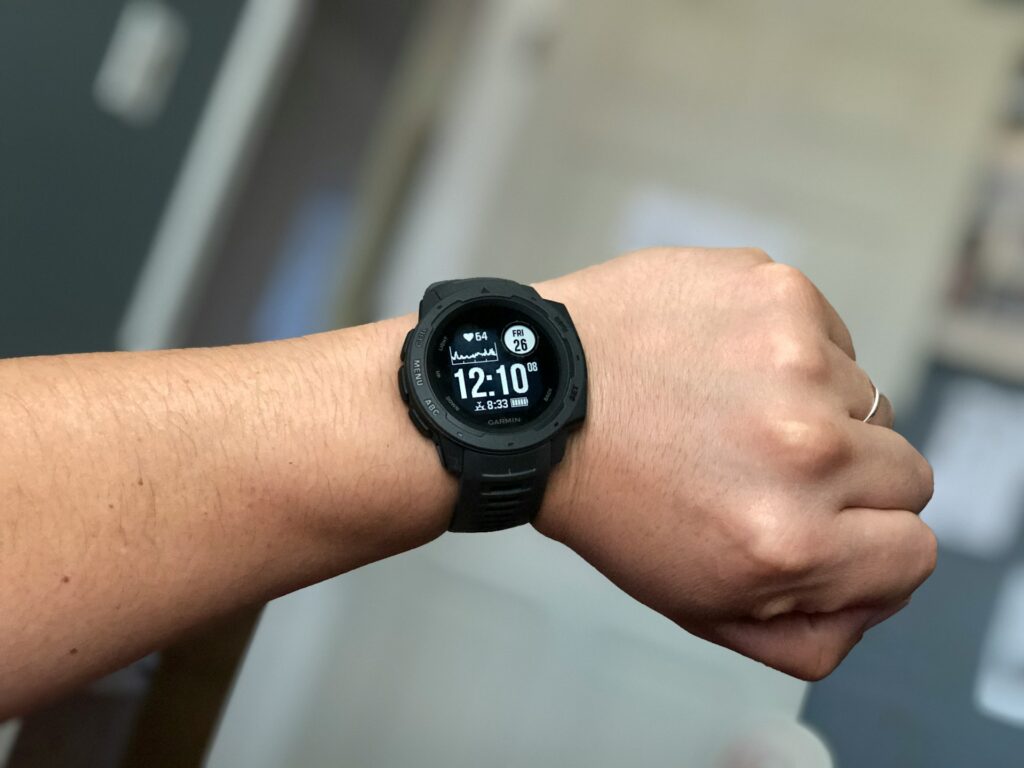Strava vs. Garmin: The Fitness Tech Feud That Could Break Your Workout Routine

Oct 28 | 2025

Photo by Chander R on Unsplash
This article includes affiliate links. We may earn a commission if you make a purchase, with no extra cost to you.
For years, Strava and Garmin have been the dream duo of endurance athletes everywhere — Garmin handling the data-tracking hardware, Strava powering the social bragging rights. But that partnership just hit a major snag: Strava has filed a lawsuit against Garmin, accusing the GPS giant of patent infringement and violating a decade-old cooperation agreement.
If you use a Garmin watch to upload workouts to Strava, this feud could eventually affect how — or even if — your data syncs.
What the Lawsuit Is Really About
According to the legal filings, Strava claims Garmin copied two core innovations:
- Segments & leaderboards, which let users compare performance over identical stretches of road or trail.
- Heatmaps & popularity routing, which visualize where people most often run or cycle.
Strava alleges Garmin embedded similar tools across its devices — including the Fenix, Forerunner, Edge, and Epix lines — without proper authorization.
The company is demanding monetary damages and an injunction to halt sales of Garmin devices containing the disputed features.
So far, Garmin hasn’t publicly commented on the lawsuit, though analysts suggest the case could drag out and disrupt integrations that millions of athletes rely on.
A Branding Battle Behind the Scenes
This isn’t just about patents — it’s also about branding and control.
Garmin recently updated its developer API rules, requiring apps like Strava to display the Garmin logo whenever Garmin-sourced data appears. Strava’s Chief Product Officer, Matt Salazar, called it “forced advertising” that would clutter user interfaces and weaken Strava’s brand identity.
Strava argues that Garmin’s policy effectively turns Strava into a billboard — and violates their long-standing agreement to keep integrations “clean” and user-centric.
Garmin, on the other hand, says it’s enforcing consistency across its ecosystem. But critics see the move as a power grab that puts Garmin one step closer to building its own social fitness platform — something that could directly challenge Strava’s dominance.

Suunto Enters the Chat
Just when Garmin’s lawyers thought things couldn’t get worse, Suunto — another major sports tech player — filed a separate lawsuit in Texas, accusing Garmin of infringing five patents tied to activity sensors and GPS innovations.
That means Garmin now faces legal battles on multiple fronts, all while trying to maintain smooth functionality across its ecosystem and third-party integrations.
For users, the timing is rough: race season is in full swing, and millions of athletes depend on Garmin-to-Strava syncing for daily tracking and motivation.
What It Means for You
Right now, Garmin-to-Strava syncing still works, but cracks are showing. Some users are reporting failed uploads or repeated “reauthorization” prompts.
Strava insists it won’t intentionally disrupt data flow — but if Garmin cuts off API access, uploads could stop overnight.
Here’s what you can do:
✅ Back up your workouts — Export .FIT or .GPX files from both Garmin Connect and Strava.
✅ Reconnect integrations — If syncing fails, disconnect and reauthorize within Garmin Connect.
✅ Watch for firmware updates — If Garmin is forced to comply, features like Live Segments or popularity heatmaps could quietly disappear.
✅ Keep your options open — Start exploring backup platforms or apps now before you’re locked out.
For Garmin Users: Do You Even Need Strava?
Here’s where things get interesting — because many argue the watch matters more than the app.
Garmin devices are powerful on their own. They record heart rate variability, cadence, VO₂ max, and even body battery levels with precision. While Strava makes that data social, the data itself lives in Garmin Connect — and can easily sync to other platforms.
That means if Strava cuts the cord, you won’t lose your data — you’ll just lose Strava’s social layer.
Why Your Device Is More Valuable Than Any App
- Accuracy lives in hardware. A reliable GPS watch ensures clean data. Apps only interpret it.
- Battery life = independence. Garmin devices can last days without recharging — something no app can fix.
- Open data formats. Garmin’s
.FITfiles can be imported to dozens of platforms. - Firmware updates keep evolving. Garmin continues to add training load, performance metrics, and race predictions directly in its own app.
In short: if you own a Garmin, you’re not trapped. You’re equipped.
The Best App Alternatives to Strava for Garmin Users
If the lawsuit ever breaks the sync link, you have plenty of strong alternatives. These apps either integrate directly with Garmin Connect or allow easy file import.
| App / Platform | Why It’s Great for Garmin Users | Considerations |
|---|---|---|
| Garmin Connect | Native ecosystem with deepest device compatibility, full metrics, and tight firmware features; Connect Plus adds advanced insights. | Limited social/segment vibe compared to Strava; some advanced features sit behind a paywall. |
| RideWithGPS | Best-in-class route creation and navigation; syncs routes/activities smoothly with Garmin devices. | Turn-by-turn and offline maps typically require a paid tier. |
| Komoot | Excellent discovery for trails and off-road routes; strong turn-by-turn navigation to Garmin. | Lighter on social competition; more explorer-focused than leaderboard-driven. |
| TrainingPeaks | Pro-grade structured workouts and analytics; widely used by coaches; integrates cleanly with Garmin. | Most advanced analysis and planning are paid features; minimal social feed. |
| Golden Cheetah | Open-source desktop analytics; full control of FIT/TCX files without cloud lock-in. | Steeper learning curve; interface is utilitarian; no built-in social layer. |
| Wikiloc | Great for hiking/trail GPX discovery and sharing; easy export to Garmin. | Focused on navigation and route sharing over deep performance metrics. |
The Bottom Line
The Strava vs Garmin lawsuit might seem like a corporate scuffle, but it highlights something bigger: how fragile the links between fitness platforms can be.
Garmin devices will continue tracking workouts accurately, no matter what happens in court. Apps will come and go — but reliable data, stored in open formats, ensures your progress never disappears.
So yes, Strava may have invented the leaderboard — but Garmin built the watch that made you fast enough to climb it.
Keep tracking. Keep training. And keep your data where it belongs — with you.
- Segments & leaderboards, which let users compare performance over identical stretches of road or trail.
- Heatmaps & popularity routing, which visualize where people most often run or cycle.
Strava alleges Garmin embedded similar tools across its devices — including the Fenix, Forerunner, Edge, and Epix lines — without proper authorization.
The company is demanding monetary damages and an injunction to halt sales of Garmin devices containing the disputed features.
So far, Garmin hasn’t publicly commented on the lawsuit, though analysts suggest the case could drag out and disrupt integrations that millions of athletes rely on.
A Branding Battle Behind the Scenes
This isn’t just about patents — it’s also about branding and control.
Garmin recently updated its developer API rules, requiring apps like Strava to display the Garmin logo whenever Garmin-sourced data appears. Strava’s Chief Product Officer, Matt Salazar, called it “forced advertising” that would clutter user interfaces and weaken Strava’s brand identity.
Strava argues that Garmin’s policy effectively turns Strava into a billboard — and violates their long-standing agreement to keep integrations “clean” and user-centric.
Garmin, on the other hand, says it’s enforcing consistency across its ecosystem. But critics see the move as a power grab that puts Garmin one step closer to building its own social fitness platform — something that could directly challenge Strava’s dominance.

Suunto Enters the Chat
Just when Garmin’s lawyers thought things couldn’t get worse, Suunto — another major sports tech player — filed a separate lawsuit in Texas, accusing Garmin of infringing five patents tied to activity sensors and GPS innovations.
That means Garmin now faces legal battles on multiple fronts, all while trying to maintain smooth functionality across its ecosystem and third-party integrations.
For users, the timing is rough: race season is in full swing, and millions of athletes depend on Garmin-to-Strava syncing for daily tracking and motivation.
What It Means for You
Right now, Garmin-to-Strava syncing still works, but cracks are showing. Some users are reporting failed uploads or repeated “reauthorization” prompts.
Strava insists it won’t intentionally disrupt data flow — but if Garmin cuts off API access, uploads could stop overnight.
Here’s what you can do:
✅ Back up your workouts — Export .FIT or .GPX files from both Garmin Connect and Strava.
✅ Reconnect integrations — If syncing fails, disconnect and reauthorize within Garmin Connect.
✅ Watch for firmware updates — If Garmin is forced to comply, features like Live Segments or popularity heatmaps could quietly disappear.
✅ Keep your options open — Start exploring backup platforms or apps now before you’re locked out.
For Garmin Users: Do You Even Need Strava?
Here’s where things get interesting — because many argue the watch matters more than the app.
Garmin devices are powerful on their own. They record heart rate variability, cadence, VO₂ max, and even body battery levels with precision. While Strava makes that data social, the data itself lives in Garmin Connect — and can easily sync to other platforms.
That means if Strava cuts the cord, you won’t lose your data — you’ll just lose Strava’s social layer.
Why Your Device Is More Valuable Than Any App
- Accuracy lives in hardware. A reliable GPS watch ensures clean data. Apps only interpret it.
- Battery life = independence. Garmin devices can last days without recharging — something no app can fix.
- Open data formats. Garmin’s
.FITfiles can be imported to dozens of platforms. - Firmware updates keep evolving. Garmin continues to add training load, performance metrics, and race predictions directly in its own app.
In short: if you own a Garmin, you’re not trapped. You’re equipped.
The Best App Alternatives to Strava for Garmin Users
If the lawsuit ever breaks the sync link, you have plenty of strong alternatives. These apps either integrate directly with Garmin Connect or allow easy file import.
| App / Platform | Why It’s Great for Garmin Users | Considerations |
|---|---|---|
| Garmin Connect | Native ecosystem with deepest device compatibility, full metrics, and tight firmware features; Connect Plus adds advanced insights. | Limited social/segment vibe compared to Strava; some advanced features sit behind a paywall. |
| RideWithGPS | Best-in-class route creation and navigation; syncs routes/activities smoothly with Garmin devices. | Turn-by-turn and offline maps typically require a paid tier. |
| Komoot | Excellent discovery for trails and off-road routes; strong turn-by-turn navigation to Garmin. | Lighter on social competition; more explorer-focused than leaderboard-driven. |
| TrainingPeaks | Pro-grade structured workouts and analytics; widely used by coaches; integrates cleanly with Garmin. | Most advanced analysis and planning are paid features; minimal social feed. |
| Golden Cheetah | Open-source desktop analytics; full control of FIT/TCX files without cloud lock-in. | Steeper learning curve; interface is utilitarian; no built-in social layer. |
| Wikiloc | Great for hiking/trail GPX discovery and sharing; easy export to Garmin. | Focused on navigation and route sharing over deep performance metrics. |
The Bottom Line
The Strava vs Garmin lawsuit might seem like a corporate scuffle, but it highlights something bigger: how fragile the links between fitness platforms can be.
Garmin devices will continue tracking workouts accurately, no matter what happens in court. Apps will come and go — but reliable data, stored in open formats, ensures your progress never disappears.
So yes, Strava may have invented the leaderboard — but Garmin built the watch that made you fast enough to climb it.
Keep tracking. Keep training. And keep your data where it belongs — with you.
"









